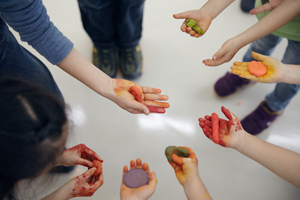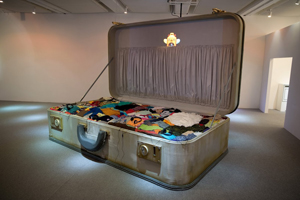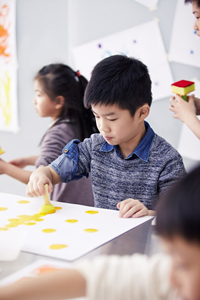A gift for kids: Taipei Children's Art Education Center
By Yali Chen The center was finished with funds from the Taipei City Government and TSMC Education and Culture Foundation. The project has taken five years and NT$28 million to complete. At the opening ceremony, Taipei City Mayor Hau Lung-bin expressed his gratitude for the contribution that the TSMC Education and Culture Foundation had made. He cited such collaboration as a good example of promoting arts education through the integration of public and private resources. Making a case for a well rounded education, Hau believed that the promotion of aesthetic cultivation will contribute to the development of good citizenship and also hoped that the center will function as a good place for kids to nurture their artistic creativity. "The center has a special method for educating children," the TFAM director Huang Hai-ming said. "We use teamwork and interaction, encouraging them to develop a taste for aesthetics and arts appreciation." Hsinchu-based Taiwan Semiconductor Manufacturing Co., the world's largest custom-chip maker, has been devoted to humanities education over the past few decades. The TSMC Education and Culture Foundation chose aesthetic cultivation as the first step in promoting humanities education in 2002. Since then the foundation has invited nearly 80,000 low-income students and students from rural schools to visit the Taipei Fine Arts Museum and National Palace Museum. "It's a great honor to support the city government's project. We believe that the center will become the most important platform for promoting children's art education in Taiwan," the foundation chairman Tseng Fan-cheng said. The center has an exhibition room, an interactive showcase area, a creative workshop, and an area for preschool aged children. The center features a wide variety of installation artworks providing interactive and sensory experiences because its goal is to develop a sense of aesthetics and an appreciation for the joy of art in young children. In an effort to mark Children's Day, the center is holding an exhibition titled "The Gift," which will run until September 14. The center's first exhibition also symbolizes the "present" of this new facility for kids, Hau said, adding that in the exhibition room dedicated to children, young visitors can interact with artworks and take part in hands-on creativity events. Some day their works may have a chance to be showcased in the center. The showcase is divided into four sections: "My Precious Gift," "Gift Wrapping," "Time Cheque," and "In the Name of a Gift," as well as an interactive area "Wonderland of Gifts." The first area, "My Precious Gift" presents a total of 81 objects of special personal significance collected by the TFAM from the general public. Their owners have written stories about these carefully kept objects. The Taipei-based Flying Group Theater has organized the second area, "Gift Wrapping" and created a piece of installation artwork – an old, oversized suitcase symbolizing one person's colorful life. The suitcase is filled with a wide variety of clothing that means treasured memories from the cradle to the grave. In the four area, "In the Name of a Gift," a total of eight contemporary artists were invited to use their artworks in a bid to interpret the idea of a gift. These artists include Page Tsou, Chen Yi-jian (also known as E Chen), Yeh Wei-li, Kao Chung-li, Yuan Goang-ming, Wang Ya-hui, Chen Chieh-jen, and Chang Chien-chi. Each artist's work will be put on display starting April 4, April 22, May 13, June 3, June 24, July 15, August 5, and August 26 respectively. The interactive area, "Wonderland of Gifts" is designed for reading and creation. Children can read books specially chosen for their subjects, touching stories and unlimited imagination are featured in this area. They are also invited to use crayons on hand to draw a picture as a unique gift for their families and friends. The opening of the first children's art education center in the public fine arts museum acts as an important milestone in the history of Taiwan's art education. Since 2001 the Taipei-based museum has staged art exhibitions for kids' art education in collaboration with the Centre Pompidou in Paris. Children are encouraged to explore the beauty of arts through exhibited items. In December 2010 the museum held an art exhibition, named "KoKo: From Nature to Art" and designed for parents and children. Twelve pieces of oil paintings on display at the KoKo exhibition included early Taiwanese landscape artists Yang San-lang, Liao Te-cheng, Ho Te-lai, Ma Pai-sui, Hsi-Te-chin, Chu Teh-chun, Lu Chi-cheng, Li Che-fan, Lin Tein-jui, Gao Yeh-jung, Cheng Shih-fan, and Yang Qi-dong. Through these artworks, children could learn how artists used different ways to depict colors, neighborhoods, countryside, mountains, famous sites and scenic spots on their canvases. The museum used hands-on interactive devices to help parents and kids explore their everyday life from an artistic point of view. The family-friendly installation of devices also aimed to assist young viewers in developing their observation skills. In his opinion, skills developed in art education often transfer to other areas of life and school work because art projects require kids to use their fine motor skills to complete tasks. Holding a narrow paint brush, cutting with scissors and sculpting clay are a few examples of art activities that use fine motor skills and hand-eye coordination. The more often they practice the fine motor skills, the more improved they become. The improved fine motor control carry over to other situations that require hand-eye coordination and other precise movements. Meanwhile, by participating in open-ended art projects, children get a chance to practice those skills without being judged on the outcomes. Clearly, visiting an art museum can expose children to a diversity of ideas that challenge them with different perspectives on the human condition. Expanding access to art, whether through programs in schools or through visits to area museums and galleries, should be a central part of any school's curriculum. Children's first visit to an art museum can be very exciting and influence their feelings about art for years to come. Here are a few ways parents can turn any art museum visit into a fun family adventure. Start by making your trips to museums short and sweet. An hour is long enough for a small child, not only in terms of keeping their attention, but from a physical point of view as well. Parents can also spark a child's interest in art through family discussions, playful games and imaginative conversations.
Staff WriterThe Children's Art Education Center, located in the Taipei Fine Arts Museum (TFAM), opened this past April 4, which coincides with Children's Day in Taiwan.
 The foundation director Sophie Chang was also glad that the city government can set up the first children's art education center in the public fine arts museum. Apart from the city's kids, she encouraged low-income students and students from rural schools to visit the center at no cost.
The foundation director Sophie Chang was also glad that the city government can set up the first children's art education center in the public fine arts museum. Apart from the city's kids, she encouraged low-income students and students from rural schools to visit the center at no cost. Taiwanese artist Alice Wang's work, "Time Cheque" turns an individual's time into a gift. In her opinion, giving one's own time to another person is both an act of selflessness and a true gift that asks for nothing in return.
Taiwanese artist Alice Wang's work, "Time Cheque" turns an individual's time into a gift. In her opinion, giving one's own time to another person is both an act of selflessness and a true gift that asks for nothing in return. Students who have visited the museum on a field trip will demonstrate stronger critical thinking skills, display higher levels of social tolerance, generate social responsibility, exhibit greater historical empathy, and develop a taste for art museums and cultural institutions, the Taipei-based museum director Huang said.
Students who have visited the museum on a field trip will demonstrate stronger critical thinking skills, display higher levels of social tolerance, generate social responsibility, exhibit greater historical empathy, and develop a taste for art museums and cultural institutions, the Taipei-based museum director Huang said.

![Taiwan.gov.tw [ open a new window]](/images/egov.png)
